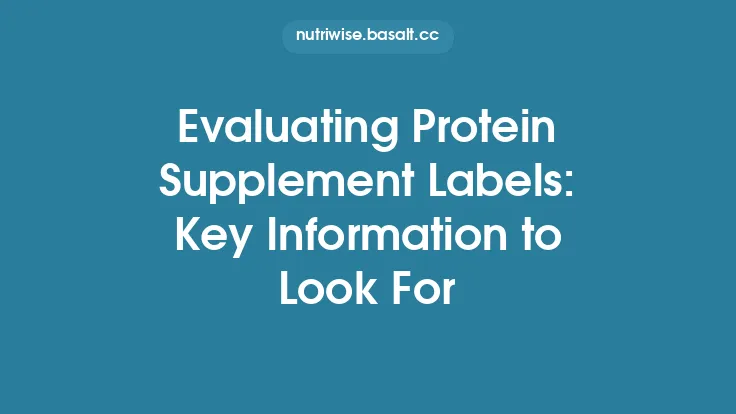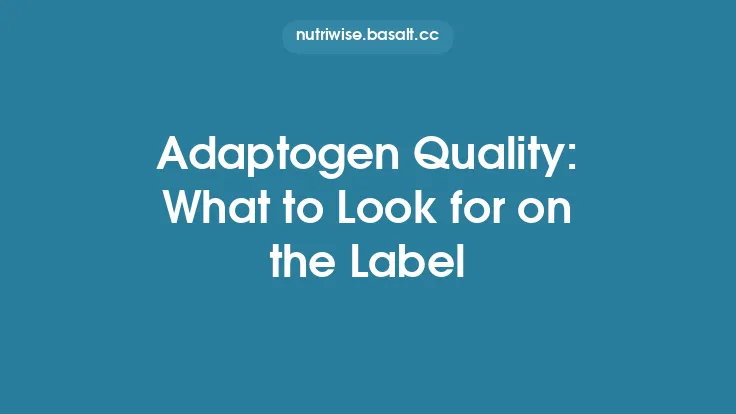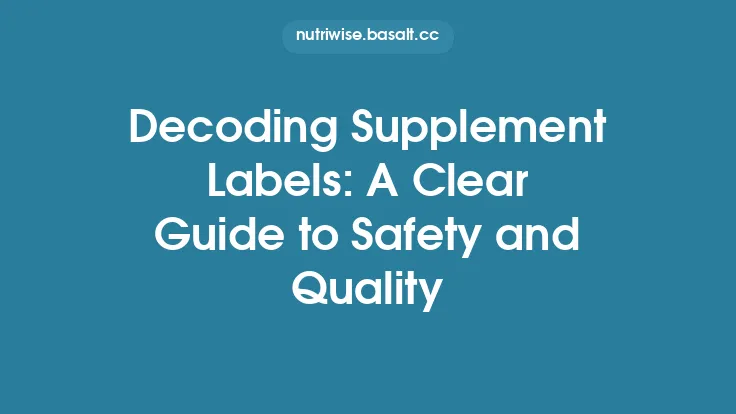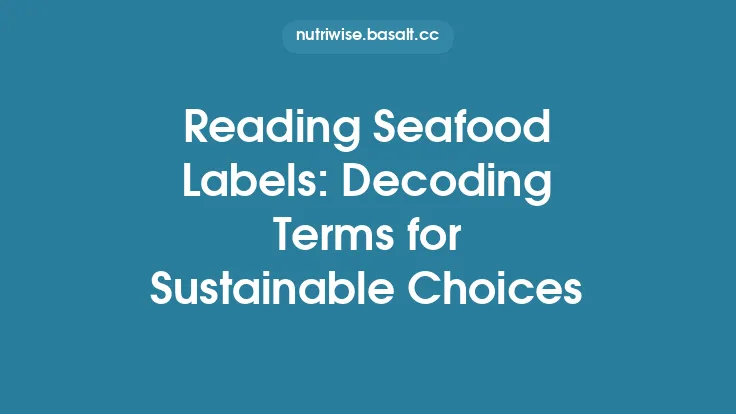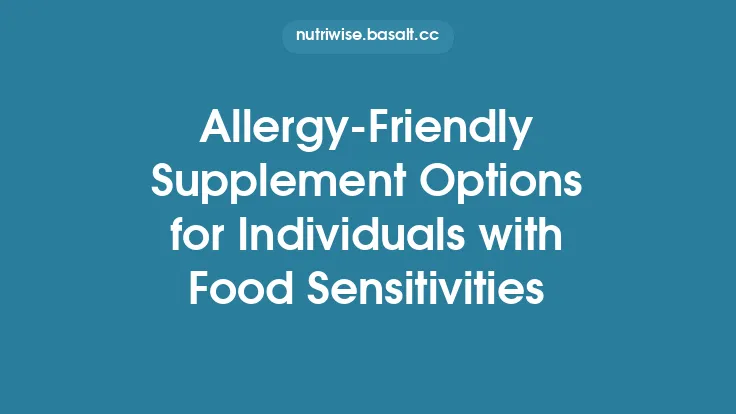When you pick up an omega‑3 supplement, the bottle’s label is the most reliable source of information about what you’re actually consuming. While marketing copy can be persuasive, the regulatory‑required sections of the label provide the factual details you need to assess potency, purity, safety, and suitability for your personal circumstances. By systematically reviewing each component, you can make an informed decision and avoid common pitfalls such as hidden fillers, inaccurate dosing, or undisclosed allergens.
Understanding the Supplement Facts Panel
The Supplement Facts panel is the cornerstone of label analysis. It lists the active omega‑3 ingredients—typically eicosapentaenoic acid (EPA) and docosahexaenoic acid (DHA)—along with their exact amounts per serving. Pay close attention to:
- Total omega‑3s – This is the sum of EPA, DHA, and any other omega‑3 fatty acids present. It tells you the overall potency of the product.
- Individual EPA/DHA values – Some formulations emphasize one over the other. Knowing the split helps you compare products that claim “high EPA” or “high DHA.”
- Serving size – The amount of product (e.g., 2 softgels, 1 teaspoon) that delivers the listed omega‑3 content. Adjust calculations if you plan to take a different number of capsules or a different volume.
- Other nutrients – Occasionally, manufacturers add vitamin E, vitamin D, or other micronutrients. These are listed separately and can affect the overall nutritional profile.
Identifying the Source and Form of the Oil
Omega‑3s can be delivered in several chemical forms, each with distinct absorption characteristics and stability profiles:
| Form | Typical Source | Key Label Indicators |
|---|---|---|
| Triglyceride (TG) | Natural fish oil | “Triglyceride form” or “natural TG” |
| Ethyl ester (EE) | Concentrated fish oil | “Ethyl ester” |
| Re-esterified TG (rTG) | Processed to restore TG structure | “Re-esterified triglyceride” |
| Phospholipid (PL) | Krill oil | “Phospholipid” or “krill oil” |
| Structured lipid | Specialty blends | “Structured lipid” |
The label should explicitly state the form; if it does not, you may need to contact the manufacturer for clarification. The form influences both bioavailability and the likelihood of oxidation, so it is a critical piece of information for discerning product quality.
Assessing Purity and Oxidation Controls
- Oxidation values – Look for “peroxide value (PV)” and “anisidine value (AV)” on the label or accompanying documentation. Low PV (<5 meq O₂/kg) and AV (<20) indicate minimal oxidation. Some brands list these values directly; others provide them on a QR code or website link.
- Molecular distillation – If the label mentions “molecularly distilled” or “double‑distilled,” it signals an extra step to remove contaminants such as heavy metals, PCBs, and dioxins.
- Third‑party certifications – Independent testing seals (e.g., IFOS, USP, NSF, GOED) are often displayed on the front or back of the bottle. These logos confirm that the product has met specific purity and potency standards. Verify the certification’s scope (e.g., “IFOS 5‑star rating for EPA/DHA content and contaminants”).
Evaluating Additives, Fillers, and Excipients
Not all ingredients are listed under the Supplement Facts panel. The “Other Ingredients” section reveals binders, anti‑caking agents, flavorings, and coating materials. Common items include:
- Gelatin – Indicates a traditional softgel capsule; may be derived from bovine or porcine sources.
- Vegetable cellulose – Used in vegan capsules; often listed as “cellulose” or “hydroxypropyl methylcellulose (HPMC).”
- Soy lecithin – Serves as an emulsifier; relevant for individuals with soy allergies.
- Natural flavors or sweeteners – May affect taste but can also introduce allergens.
If you have dietary restrictions (e.g., vegetarian, kosher, halal) or specific sensitivities, cross‑reference these ingredients with your requirements.
Reading the Expiration and Storage Information
- Best‑by date – Omega‑3 oils are prone to oxidation over time. A date that is at least 12–18 months from the purchase date is a good indicator of product freshness.
- Storage instructions – Labels often advise “store in a cool, dry place” or “refrigerate after opening.” Following these guidelines helps maintain potency and prevents rancidity.
Understanding Dosage Recommendations and Label Claims
- Suggested use – The label will specify how many capsules or how much liquid to take per day. This recommendation is based on the product’s EPA/DHA content, not on therapeutic dosing.
- Health claims – In many jurisdictions, supplement labels may include structure‑function statements (e.g., “supports heart health”). These are not evaluated by regulatory agencies and should be considered marketing language rather than evidence‑based guidance.
Checking for Allergen and Sensitivity Information
Regulatory bodies require clear allergen labeling. Look for statements such as:
- “Contains fish” – Mandatory for fish‑derived omega‑3s.
- “May contain traces of shellfish, nuts, or soy” – Indicates potential cross‑contamination during manufacturing.
If you have a known allergy, ensure the product’s allergen warnings align with your safety needs.
Verifying Manufacturer Transparency and Contact Details
A reputable label will include:
- Full company name and address – Enables you to verify the manufacturer’s location and contact them if needed.
- Batch/lot number – Essential for traceability; you can request a Certificate of Analysis (CoA) for that specific batch.
- Customer service phone or email – Facilitates follow‑up questions about the product’s composition or testing results.
When a company readily provides a CoA upon request, it demonstrates confidence in its quality control processes.
Interpreting Legal and Regulatory Statements
- “Dietary supplement” disclaimer – Indicates the product is not intended to diagnose, treat, cure, or prevent any disease.
- “Not evaluated by the FDA” – Standard language for supplements sold in the United States; it does not imply the product is unsafe, but it underscores the importance of label scrutiny.
- Country of origin – Some labels note where the fish oil was sourced (e.g., “sourced from wild‑caught anchovies, Peru”). While this is not a guarantee of sustainability, it can be useful for assessing potential contaminant exposure based on regional water quality data.
Putting It All Together: A Practical Checklist
- Read the Supplement Facts panel – Confirm total omega‑3s, EPA/DHA split, and serving size.
- Identify the oil form – TG, EE, rTG, PL, or structured lipid.
- Check purity metrics – Look for PV/AV values or third‑party certification logos.
- Review other ingredients – Note any allergens, binders, or capsule materials.
- Verify expiration date and storage guidance – Ensure freshness and proper handling.
- Assess dosage instructions – Align suggested use with your intended intake.
- Confirm allergen statements – Ensure no hidden sources of allergens.
- Locate manufacturer details – Batch number, contact info, and willingness to provide a CoA.
- Read legal disclaimer – Understand the regulatory context of the product.
By following this systematic approach, you can decode the information presented on omega‑3 supplement labels, differentiate between products that merely meet minimum regulatory requirements and those that demonstrate a higher standard of quality, and ultimately select a supplement that aligns with your health goals and personal preferences.
